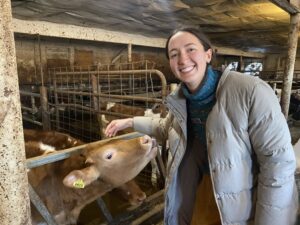From Cow to Café: Vassar Students Tour Storied Local Dairy Farm
- by Elise Dudley

Vassar College Students and Bon Appétit Fellow Elise Dudley pose during their visit to Coon Brothers Dairy, a member of Hudson Valley Fresh
When Bon Appétit Fellow Elise Dudley and over a dozen Vassar College students caravanned out to Amenia, NY earlier this year, they expected to learn firsthand about the dairy industry and meet a storied local Farm to Fork partner. They got even more, including a lesson in emerging cooperative models that protect small dairy farms.
Careening down quiet backroads and pastoral rolling fields into Amenia a couple decades ago, you would have passed one dairy farm after another. As the students recently learned, Farm to Fork vendor Coon Brothers Dairy is now the sole remaining working farm on a stretch of road that used to contain 50 dairies. A farmer-owner of Hudson Valley Fresh Dairy cooperative, Coon Brothers benefits from collaboratively set fair prices that protect their business model. Their milk is insulated from price swings in the federal price of dairy – allowing them to sustain their business and pay their workers living wages. (Read more about the lessons the group learned about Hudson Valley Fresh’s model in our companion piece to this story.)
Third generation farmer, Amos Coon, and his father, farmer Dave Coon led the tour of their farm, home to 350 dairy cows (out of roughly 700 animals on the farm total) that produce 2,500 gallons of milk each day. “We’re fortunate here to have the next generation, but a lot of farms in Dutchess County don’t have that next generation,” explained Dave. “The majority went out because it was their choice to retire and now the land’s worth too much money to sell it for milking cows.”

Bon Appétit Fellow Elise Dudley meets a Coon Brothers Dairy Guernsey
In the milking parlor, 20 cows can be milked at a time, while each cow is tracked individually for milk production and quality. They raise Holsteins, the famous black and white staple breed, well known as the world’s highest producing dairy animal, and Guernseys. The latter is a less common breed that produces milk rich in flavor, and high in fat and protein.
Beyond dairy production, the Coons also have long-term land agreements with neighboring farmland owners where they cultivate over 2,000 acres of crops used as feed and sell surplus, all while employing no-tillage methods—supportive of conservation efforts that in Dave’s words “just makes sense.” This diversified operation facilitates circularity: cows eat a diet primarily comprised of the farm’s crops and then manure is pumped into a silage tank that is used to fertilize those fields. Additionally, Coon Brothers’ stewardship of this land allows it to stay in agricultural use, at a time when more and more Hudson Valley farmland is being given over to development.
Hudson Valley Fresh’s trucks pick up milk a couple times a week before being brought to a bottling facility nearby in Kingston, NY to be minimally pasteurized and bottled for restaurants, coffee shops, and grocery stores in the Mid-Hudson Valley and neighboring New York City.
As Vassar students learned, Coon Brothers and Hudson Valley Fresh serve as an example of how dairy farming can be done in a way that preserves the farm livelihoods and landscapes that sustain us all.